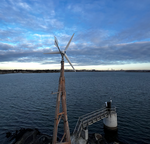New tool at Sandia brings some West Texas wind to the Duke City - virtually
A new, custom-built wind turbine emulator has been installed at Sandia’s Distributed Energy Technologies Laboratory. The emulator, which mimics actual wind turbines at Sandia’s Scaled Wind Farm Technology Site near Lubbock Texas, will be used to study how wind farms behave under multiple weather conditions and load demands, and if they can be efficiently used as a source of distributed energy for consumers who live near the farms, according to Brian Naughton, a researcher with Sandia’s Wind Energy Technologies program.
Unlike traditional wind farms that feed energy to grid-connected transmission lines, wind turbines used for distributed energy are close to or even directly connected to the end user or customer, said Naughton. This is especially important for users who are in remote areas or who are off the main electrical grid.

Rachid Darbali-Zamora examines Sandia National Laboratories’ new wind turbine motor, which will allow the distributed energy team to study how wind farms will behave under a variety of conditions and in different locations. (Image: Bret Latter)
“Right now, most wind generated power is just sent out on transmission lines to customers hundreds of miles away and can be affected by a wide variety of disruptions,” said Naughton. “Being able to test how wind turbines react to different and varying wind and weather conditions, we can help determine the viability of having generation take place closer to homes, schools and businesses.”
Determining the viability of using wind turbines as a source of distributed energy is important due to the potential impact it could have on providing electricity to remote, island communities that exist largely off the main electric grid, said Rachid Darbali-Zamora, a researcher with Sandia’s Renewable Energy and Distributed Systems Integration program.
“We’re looking at finding solutions to challenges faced by parts of the country that cannot be consistently powered by a traditional electric grid, such as remote communities in Alaska or islands that have experienced crippling devastation due to hurricanes,” said Darbali-Zamora. “Adding wind as a distributed energy source, we are potentially solving some big challenges that are faced regarding the utilization of microgrid technology.”
Faster research through innovation
By using the resources available at the Distributed Energy Technologies Laboratory, researchers will be able to exactly replicate wind, weather and load demand conditions at the Texas site, according to Naughton.
“Because the Distributed Energy Technologies Lab is so configurable, we’re able to conduct tests and simulations that are not feasible or safe to do on the actual electric grid or that we might have to wait days or weeks for conditions to be right at the wind farm site,” said Naughton. “Just like the lab can simulate weather and load conditions for solar photovoltaics and battery testing, we can now do the same thing for wind generation.”

The scaled down turbine motor is connected to software that will allow the Sandia National Laboratories team to emulate a variety of conditions and tackle the challenges of using wind power as part of a microgrid for remote communities (Image: Bret Latter)
The emulator consists of a scaled-down wind turbine motor and uses much of the same hardware and software that control actual turbines. The motor is connected to the lab’s emulator system, allowing researchers to operate the “virtual” turbine under different conditions, Naughton said.
“Because we’ve created an emulator that is as close to the real thing as possible, we can rapidly and cost-effectively go from concept to a solution to the challenges communities and utilities face regarding distributed energy generation,” said Naughton. “We also believe that the research we’re going to be conducting will have an overall benefit to grid resilience and stability, which affects everyone.”
Replicating West Texas wind in real-time simulations
In the laboratory setting, a model mimicking the Texas wind farm site’s electrical distribution system is run in real-time, generating approximately 15 kilowatts of electricity. Power from the wind turbine emulator is introduced to the simulated wind farm, influencing its behavior. In turn, responses, such as voltage variations, affect the wind turbine emulator behavior. This also allows the emulator to interact with other physical devices inside the Distributed Energy Technologies Lab such as solar photovoltaic inverters and protection systems, said Sandia’s Jon Berg, with the Wind Energy Technology’s program.
“Wind as strong as 25 meters per second interacting with the rotor blades is represented by a motor drive that we can program to duplicate how the rotor speed would respond,” said Berg. “The torque being created then causes the emulator to produce electricity, just like the actual turbine does, as the turbine control system commands the power converter and generator to resist the input torque.”
Naughton, Darbali-Zamora and Berg all believe that the ability to apply different control schemes to the emulator and simulated environments in real time, will help identify obstacles that can arise during deployment in the field such as system communications latencies or other configuration challenges. Being able to address these in a real-time test environment will save time and money and increase efficiency of field deployment.
Funded by the U.S. Department of Energy’s Wind Energy Technologies Office, the new wind turbine emulator at Sandia is part of the Microgrids, Infrastructure Resilience and Advanced Controls Launchpad, a collaboration between Sandia, the Idaho and Pacific Northwest national laboratories and the National Renewable Energy Laboratory. Researchers use the launchpad to advance wind-hybrid distributed energy systems to provide stability, flexibility, security and resilience to distribution systems and microgrids.
- Source:
- Sandia National Laboratories
- Author:
- Press Office
- Link:
- share-ng.sandia.gov/...
- Keywords:
- Sandia National Laboratories, tool, wind, wind farm, virtually, weather condition, research, grid, transmission line, consumer, efficiency


























